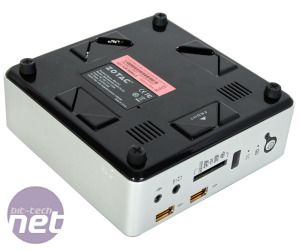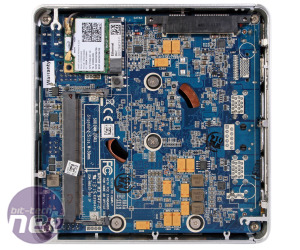
Performance Analysis
For a system based on such a low power chip, the Nano ID65 Plus does very well in our media benchmarks, with the Ivy Bridge cores again showing what they're capable of. It isn't quite able to keep pace with the desktop Core i5 Ivy Bridge part in the Zbox ID89 Plus, but it stays way head of the Celeron based ID42 Plus as well as Intel's NUC. It even manages to beat AMD's flagship desktop APU, the A10-6800K, in the image editing test, although it falls behind again in the video encoding and multi-tasking tests, and comes out just slower overall.Despite being the smallest Zbox we've looked at, the Nano ID65 Plus is actually the best one when it comes to games, with the HD Graphics 4000 chip being enough to give it the lead here. It offers easily playable frame rates in Skyrim, but only at 720p with low detail (AKA console settings), as in our 1080p test it completely crumbles. It's here that the AMD Richland APUs have the clearest advantage, as we saw in our onboard GPU testing that compared Intel's flagship Core i7-4770K to AMD's A10-6800K - it's just a shame AMD's chip has a 100W TDP!
In Left 4 Dead 2, the Nano ID65 Plus isn't quite able to maintain playable frame rates at 1,680 x 1,050, which is a little disappointing, but it nips along quite happily again at 720p, even with everything except anti-aliasing at the highest settings. It also again demonstrates a big lead over chips and systems that feature Intel's HD Graphics 2500.
Media playback is arguably more important than intensive processing tasks and gaming on a mini-PC, and thankfully this is an area that the new Zbox Nano excels in. From encoded 1080p trailers to full fat Blu-Ray ISOs, the system displayed all the HD files we threw at it flawlessly, with no jittery frames or out of sync audio experienced. HD Flash content on YouTube and BBC iPlayer, for example, also played without issue. Therefore, though the CPU won't let you do much beyond light gaming, there's enough power on hand to set the Zbox Nano up as a local or network attached media player.
Our final round of testing was a stress test designed to push the cooling hardware to its limits. With both Prime95 and the Unigine Heaven GPU benchmark running, we recorded maximum CPU and GPU temperatures of 87°C and 80°C respectively. These are certainly hot temperatures but both are still safely within the chip's 105°C thermal limit, and the system is never going to be stressed in the same way in real world scenarios either, so the cooler is still effective despite the cramped internal space.
The cooler's fan, however, can get a little noisy. Fans do tend to be louder the smaller they get, but the fan here instantly becomes more audible when you put the system under any real load. It's not a particularly loud noise, but the pitch of it is a little irritating. Any half decent set of speakers would be enough to drown it out, however, and we also sat closer to it in testing than many users are likely to do.
Conclusion
As the main determiner of the new Zbox Nano's performance, the Core i7-3537U is clearly a solid candidate for a low power yet still fast mini-PC. The ID65 Plus scores well in our media benchmarks, is flawless when it comes to video playback and is also fine for some light gaming, yet its CPU has a TDP of just 17W. Its networking, audio, display and external storage connections are also plentiful, and the aluminium chassis with its easy upgrade approach is appealing too, so there's really quite a lot on offer.The asking price of £550 is still a little steep, however, and that's before you've factored in another £80 or so for a copy of Windows (Linux builds are equally viable, of course). The barebones Gigabyte Brix GB-XM1-3537 is around £60 cheaper than the ID65 barebones option. It features the same CPU, but much less in the way of connectivity, and we'll need to give it a full review before drawing any firm conclusions. Bear in mind also that Zotac's own Zbox ID89 Plus is cheaper and actually comes with a faster CPU; it's just not as small or well built. Also, one can't discount the Mac mini, which starts at only £499, including a 500GB hard drive and 4GB RAM, and has a build that is the next step up in quality.
As it stands, then, the Zbox Nano ID65 Plus is another example of a powerful yet tiny mini-PC from Zotac. It offers just about everything you could ask for from such a system, and if space is truly at a premium then you'll be hard pressed to find something with so small a footprint that can match its performance. As the Plus model offers no extra value for money than buying the barebones package, the latter is our recommended choice, as you can then tailor it to your own needs.

-
Performance20 / 25
-
Features23 / 25
-
Design23 / 25
-
Value17 / 25


MSI MPG Velox 100R Chassis Review
October 14 2021 | 15:04











Want to comment? Please log in.